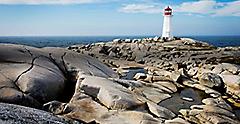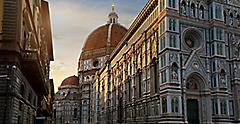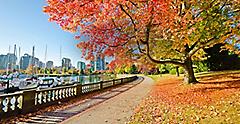
Thanks to its Canadian and French influences, Quebec is home to some of Canada's most exquisite chateaus and buildings. Don't miss the impressive architecture of Quebec City and its charming Old Quebec neighborhood. You can also stay at one of the Fairmont's many stunning chateaus across the province and feel like royalty for the weekend. Here are the best places across Quebec to see the most beautiful buildings and chateaus.
Traditionally, the word chateau was used to describe a large country house or castle in a French-speaking region. Today, Quebec is still home to many prestigious chateaus, as well as an abundance of other impressive buildings and churches. If you're searching for Quebec's best architecture, we've got you covered.
1. Quebec City
Old Quebec in Quebec City oozes European charm. The UNESCO World Heritage Site is surrounded by 17th-century fortifications, which makes it the only fortified city north of Mexico. Strolling through its charming cobblestone streets, you will easily be impressed by the architecture of Quebec City. La Citadelle is a National Historic Site that sits atop Old Quebec's Cap Diamant. The star-shaped fortification is an active military base, with amazing views over Quebec City and the Saint Lawrence River. For visitors, there are guided tours, museum exhibits and a changing of the guard ceremony.
Another architectural and historical gem to see in Old Quebec is Place-Royale. This is where the first French settlement began in 1608. Today, the square's stone buildings are home to a plethora of souvenir shops and restaurants. It is also where you'll find Notre-Dame-des-Victoires Church. As North America's oldest stone church, it dates back to 1688. Visit the city hall in Old Quebec, which was inaugurated in 1896. It unexpectedly includes classical, medieval and chateauesque architectural elements.
However, the most beautiful building in Quebec City is undeniably Château Frontenac. From its dominating position overlooking Old Quebec and the Saint Lawrence River, the Fairmont property is said to be the world's most photographed hotel. Built by the Canadian Pacific Railway, it first opened in 1893. It was built in the chateauesque architectural style, with turrets, marble interiors, and Gothic and Victorian elements. Château Frontenac has 611 guest rooms and themed suites. This includes the Trudeau Trudeau, Churchill, Elizabeth II and Celine Dion suites (a Canadian icon). Fun fact: Inside the hotel, you will find 12 kilometers (ca. 7.46 miles) of hallways.
So, if you're looking for the most beautiful buildings in Quebec City, make a beeline for Old Quebec. But one building outside this designation that deserves a mention is the Parliament Building. Like many other important European and American buildings constructed in the late 19th century, it was built in the Second Empire architectural style.
2. Montreal
Montreal is Quebec's largest city. Its Old Montreal neighborhood has the same cobblestone streets and European touch as Old Quebec. But what Old Quebec is missing is Montreal's incredible Notre-Dame Basilica. With over 11 million annual visitors, it is one of the most visited monuments in North America. This is thanks to the mesmerizing Gothic Revival architecture inside. Notre-Dame's vaulted ceilings, abundance of religious statues and stained-glass windows are accompanied by a rainbow of color, from blues to reds to silver and gold. Some of the buildings in Old Montreal date back to the 17th century. While in the area, don't miss Place Jacques-Cartier, Bonsecours Market and Château Ramezay. Built in 1705, Château Ramezay is now a museum with exhibitions on Montreal's history.
Located on Montreal's Mount Royal, Saint Joseph's Oratory is Canada's largest church. Construction began on a smaller chapel, named Saint Joseph, in 1904, but it was quickly realized that the church was too small. In 1924, construction started on Saint Joseph's Oratory, but it wasn't completed until 1967. Mount Royal (Montreal's namesake) is a popular tourist attraction in itself. It's where you'll find skyline views, the infamous Mount Royal Cross and Mount Royal Park for year-round fun.
If you're more interested in Quebec chateaus, Montreal has a spectacular one. Château Dufresne is located in Montreal's Mercier–Hochelaga-Maisonneuve neighborhood. It was built in the Beaux-Arts style between 1915 and 1918, by Parisian architect Jules Renard and Marius Dufresne. They were inspired by the Petit Trianon in Versailles, France. It was the residence of brothers Marius and Oscar Dufresne, who were both French-Canadian entrepreneurs. The building has 40 rooms, so each brother had a separate household. Since 1999, the building has housed the Dufresne-Nincheri Museum, which gives an insight into life in the 20th century.
The final destination on your architecture tour of Montreal should be Place Viger. Constructed in 1898, it was the first hotel and railway station combination in Canada. It has similarities to Old Quebec's Chateau Frontenac, as both were built in the chateauesque architectural style. The railway station closed in 1951, but today it's being used for both residential and commercial purposes. As Canada's second-largest city, a Montreal vacation is guaranteed to not be boring.
3. Montebello
Montebello is basically located directly between Ottawa and Montreal. The small town is home to two beautiful buildings. The first is Chateau Montebello, another luxury Fairmont hotel. As the world's largest log cabin, 10,000 western red cedar logs from British Columbia were used to construct Chateau Montebello. It's considered to be one of the grandest hotels built by the Canadian Pacific Railway, which is a big call when you see the other properties. The 210-room luxury hotel offers an abundance of year-round activities, like golf, cross-country skiing, dog sledding and off-road adventures.
While in the Montebello area, a visit to Parc Omega is a must. The wildlife park is home to bears, wolves, moose, bison and many other animals.
4. Tadoussac
Tadoussac is a picturesque village located three hours northeast of Quebec City. One of the oldest villages in North America, it's surrounded by water and rolling green hills. Located at the confluence of the freshwater Saguenay River and the saltwater Saint Lawrence River, Tadoussac is a rich feeding ground for marine animals. In fact, it's one of the world's best whale-watching destinations. You can see over 13 different whale species off the coast of Tadoussac from approximately May to November. This includes beluga, blue and minke whales. Another popular sight in Tadoussac is Saguenay Fjord National Park, which was created by glaciers some 10,000 years ago during the last ice age. You can hike along its majestic soaring cliffs, go on a cruise or see it from a different angle on a sea kayak.
But let's talk about Tadoussac's interesting buildings. There are no chateaus here, but it is home to one of North America's oldest wooden churches. Overlooking Tadoussac Bay, Jesuit missionaries built the Petite Chapelle in 1747. Today, you can head inside to see a small exhibition about missionary life. Next door you will find Hotel Tadoussac. Opening in 1864, the landmark hotel is distinguishable, thanks to its long red roof and whitewashed walls. The hotel's design is typical Quebec maritime architecture. Guests staying at Hotel Tadoussac get to wake up to sweeping bay views. They can also spend their free time playing tennis or mini-golf, swimming in the pool, or visiting the onsite health and wellness center.
A final historical attraction in Tadoussac is the Chauvin Trading Post, which is built to resemble North America's first fur trading post from the early 17th century. It tells the history of the first interactions between Canada's indigenous people and the Europeans.
5. Mont-Tremblant
Mont-Tremblant is a town in the Laurentian Mountains, between Ottawa and Montreal. It's most well-known as the location of two ski mountains: Mont Blanc and Mont Tremblant. As North America's second oldest ski resort, Mont-Tremblant Ski Resort is also Eastern Canada's most popular resort. It receives abundant annual snowfall and has a selection of runs for beginners to experts. It resembles a European-style pedestrian ski village — one straight out of a holiday movie.
There are plenty of hotels, restaurants and shops to choose from at Mont-Tremblant Ski Resort, which are all housed in colorful Quebecois buildings. They definitely stand out against the stark white winter snow and look as pretty as a picture. An interesting property to check out is Sommet des Neiges, which has an exterior that includes a dome, rock veneers and multiple color combinations. It's worth noting that Mont-Tremblant Ski Resort is just as much fun in the summer as it is in the winter.
6. Saguenay
Saguenay is a popular Canadian cruise port. Located up the Saguenay River from Tadoussac, the village is surrounded by identical lush greenery and water views. Just like Tadoussac, Saguenay is also home to some interesting buildings. There are no chateaus in this area of Quebec, but there is La Pulperie de Chicoutimi Regional Museum. Step back in time to the early 20th century, when the museum's buildings were used by The Chicoutimi Pulp Company. Today, the museum features permanent and temporary exhibitions on art, culture and history. It's also surrounded by a large park, which makes the perfect picnic spot.
Another interesting building (and a must-see attraction) in Saguenay is The Little White House Museum. It's said to be quite the miracle building, as it survived horrific floods in 1996 — one of Canada's worst natural disasters. The Little White House is believed to be built around 1890 and survived its first flood in 1947. The resilient property is now a museum that takes visitors through the house's history. It's suitable for the whole family. Other things to do in the area include visiting the Fjord Museum and one of the many national parks that surround Saguenay.
7. La Malbaie
La Malbaie is a small village in Quebec's charming Charlevoix region. Nestled on the north shore of the Saint Lawrence River, it's said that tourists have been visiting the area since the 18th century. La Malbaie's main attraction and most beautiful building is the Fairmont Le Manoir Richelieu. First built in 1899, the hotel was unfortunately burned down and rebuilt in 1929 in the chateauesque style. It has similar qualities to other chateaus in Quebec, including Chateau Frontenac. Sitting atop Pointe-au-Pic cliff and overlooking the Saint Lawrence River, the luxury hotel has 405 guest rooms, four restaurants and a 27-hole golf course. It even hosted the 44th G7 Summit in 2018. Next door you will find Charlevoix Casino, which has 20 game tables and a staggering 800 slot machines.
If you're lucky enough, you may time your visit to La Malbaie with the opening of the Gardens of Quatre-Vents (Four Winds). They're only open to the public a few times a year during summer. Designed by Francis H. Cabot, they're said to be one of the world's largest private gardens, with over 1,000 different plant species. Finally, if you want to arrive in La Malbaie in style, hop on the Charlevoix Train. It's one of the most scenic train journeys, as the train transports tourists from Quebec City to La Malbaie along the picturesque Saint Lawrence River. On the other side are trees, which come alive in the fall. There's no better way to get to La Malbaie.
You really will find an eclectic variety of beautiful buildings across Quebec. There's colorful ski villages, chateaus overlooking the city, and historic buildings still standing from the 18th century. So no matter your architectural preference, there's a place in Quebec for you.















